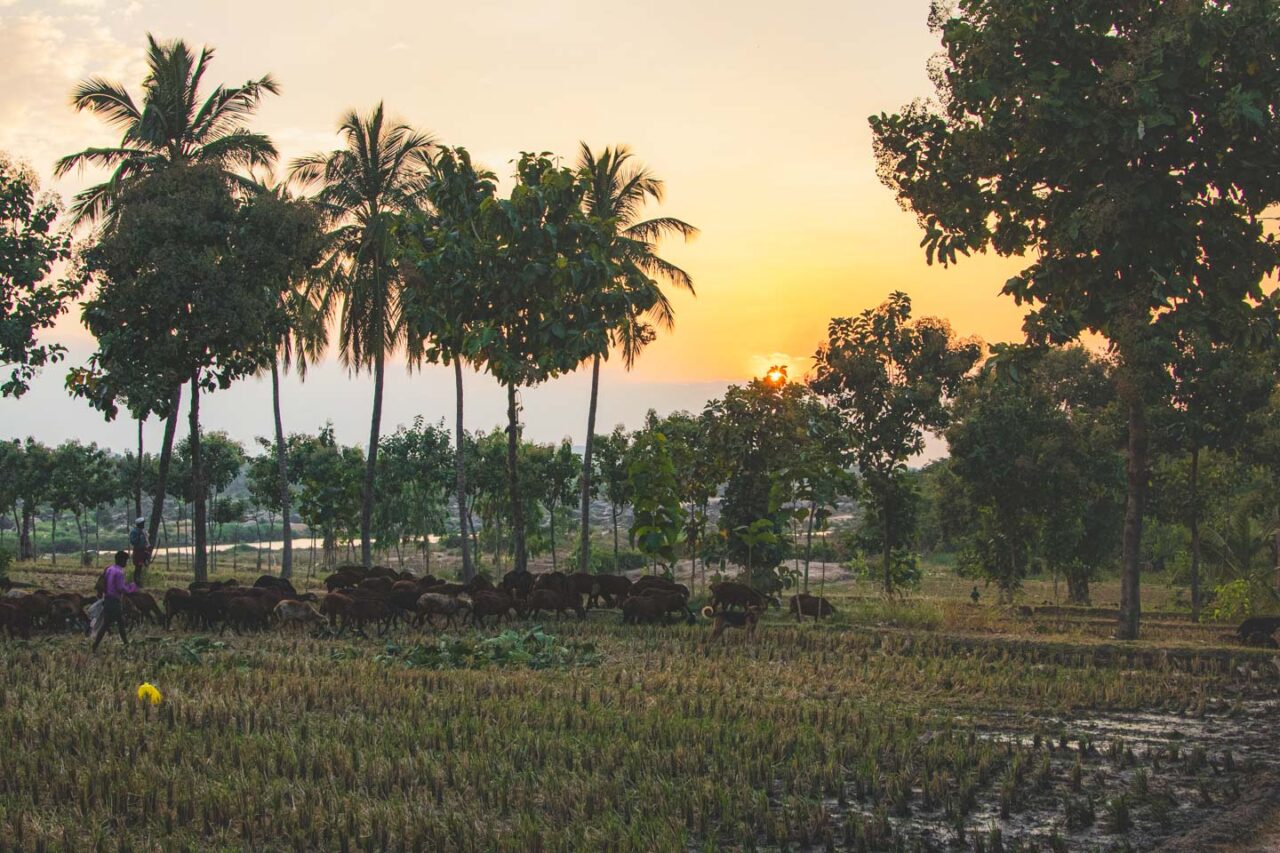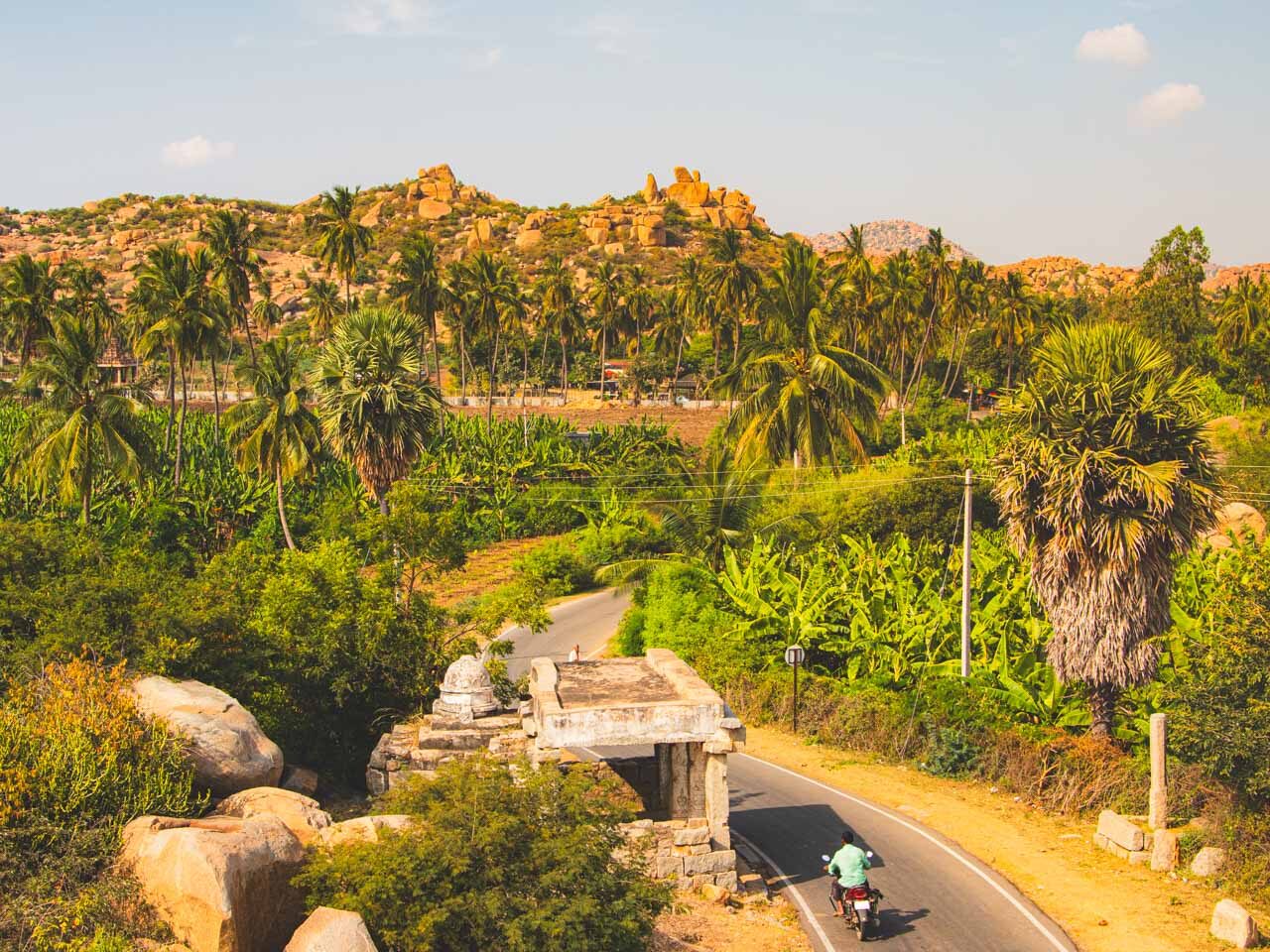Wondering what to see in Hampi, India?
You’re in the right place – here’s my complete travel guide with the best things to do, a few practical tips, and plenty of soulful reflections.
Hampi is one of those places you don’t just visit – you feel it. You listen to the silence, breathe in the dust, and read the stones like the pages of an ancient book.
Located in the Indian state of Karnataka, Hampi was once the capital of the Vijayanagara Empire – and it’s truly one of the most extraordinary places I’ve ever seen.
Full of ruins, temples, mystical boulders, and sunsets that look like watercolor paintings.
Time slows down here. The locals even have their own motto: “Don’t worry, be Hampi.” And you know what? It really works.
Hampi stays with you. See how I continued this journey through South India. After sacred hills and temple ruins, I followed the quiet road south – through palaces, jungles, tea plantations and the backwaters of Kerala.
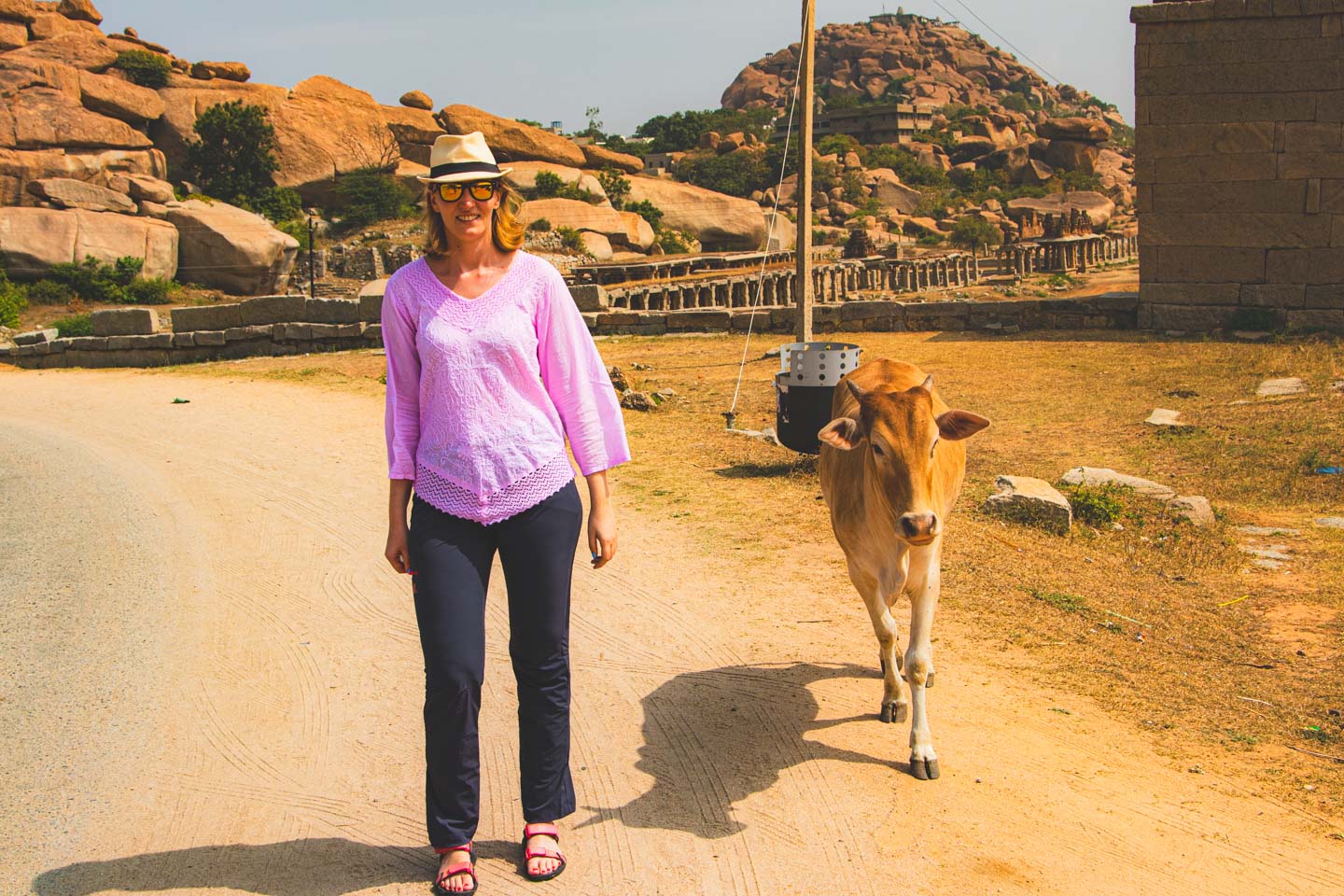
What to See in Hampi – My Map of Top Attractions
Wittala Temple – the stone chariot and musical pillars
If I had to name the most iconic temple in Hampi, it would be the Vittala Temple.
Here you’ll find the famous stone chariot dedicated to Garuda (the divine vehicle of Vishnu), and the musical pillars that produce soft sounds when gently tapped – yes, really!
There’s a small entry fee and you’ll need to take an electric cart to reach it, but the entire experience is worth it for the atmosphere alone.
Even though it was never completed, Vittala Temple leaves a lasting impression.
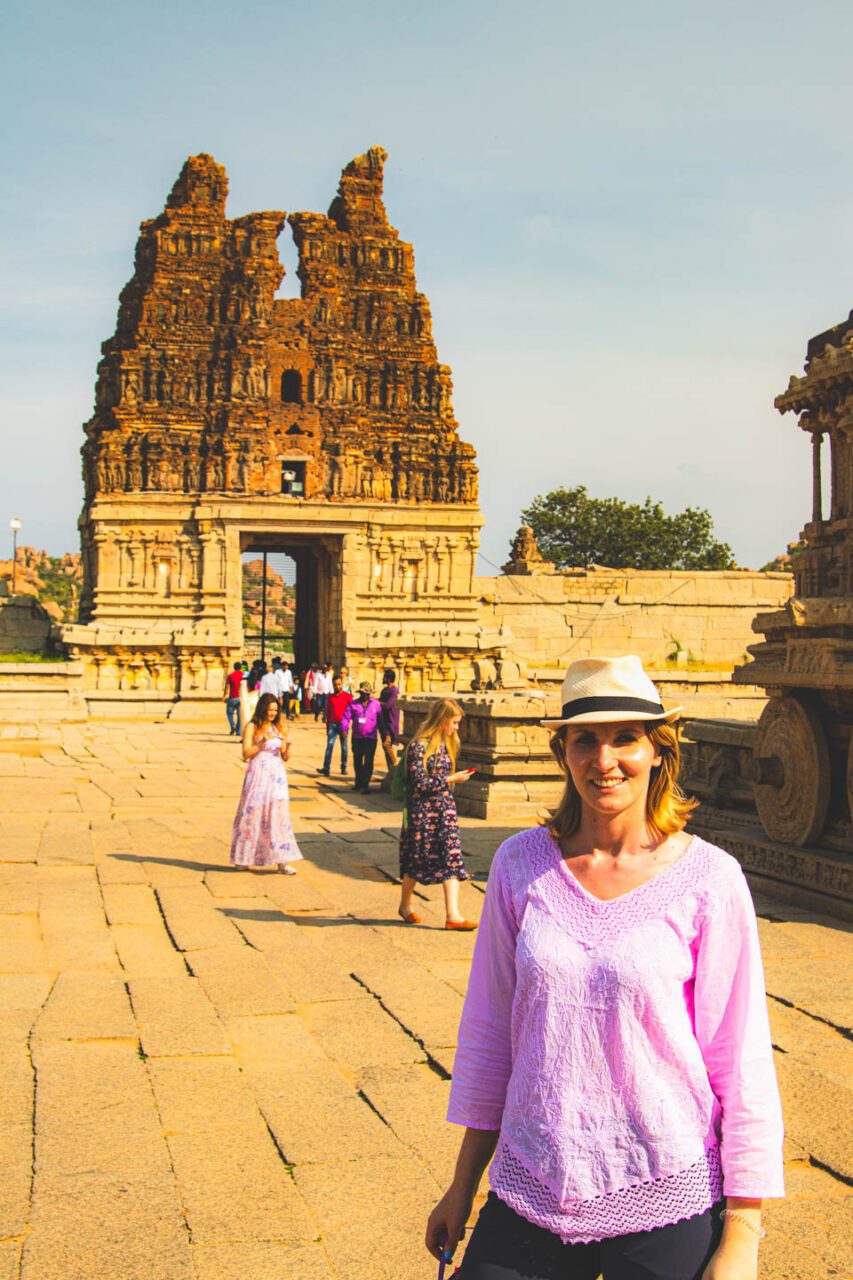
What to look for inside:
- Ranga Mantapa – the hall with 56 musical pillars
- Maha Mantapa – the main prayer hall
- Intricate carvings and architectural details
Pro tip: Come early in the morning before the tour groups arrive.
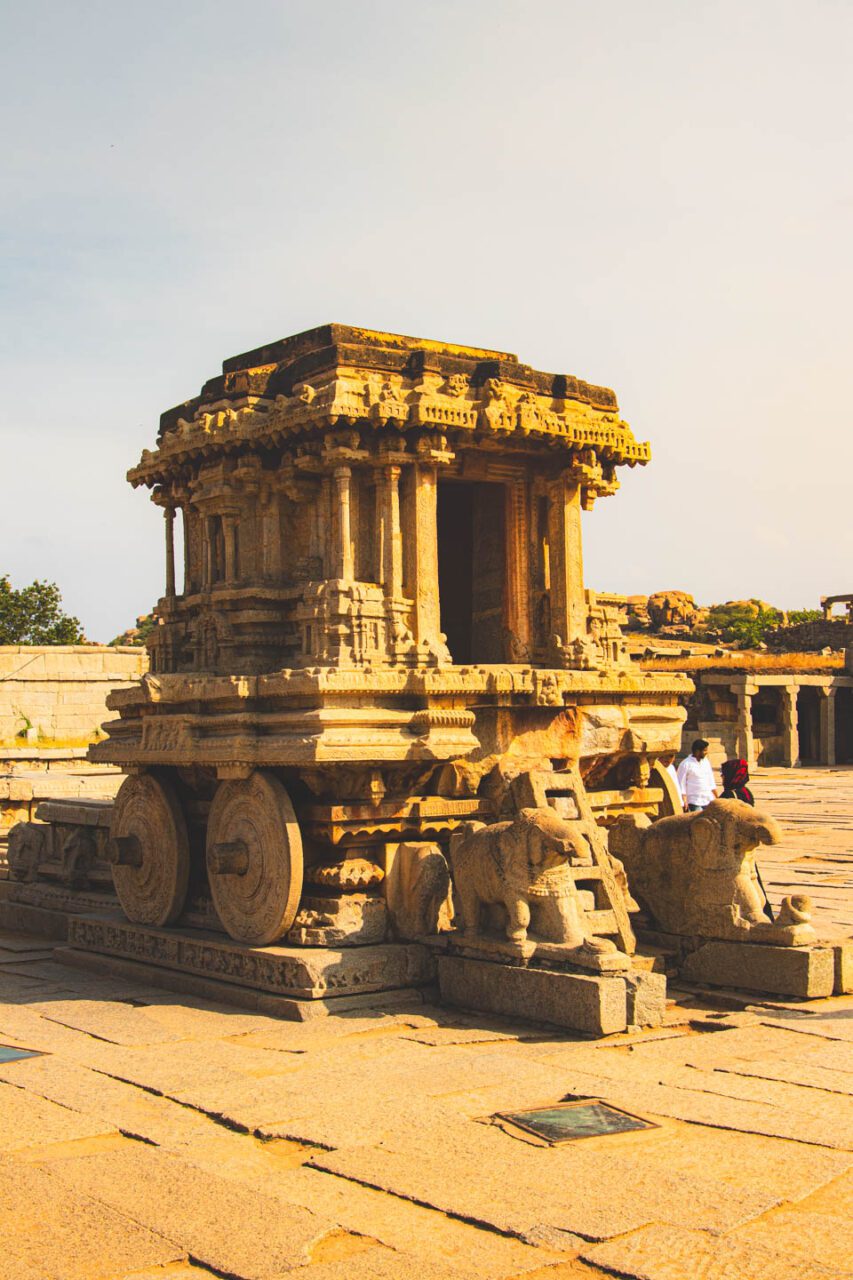
Hampi Bazaar & Virupaksha Temple – the heart of the old town
Hampi Bazaar is the lively (but still wonderfully laid-back) heart of town. You can buy local crafts, sip lassi, and watch life unfold at a slower rhythm.
Just nearby stands Virupaksha Temple – the oldest and still active temple in the area. It’s the spiritual center of Hampi, where daily rituals and pilgrimages take place.
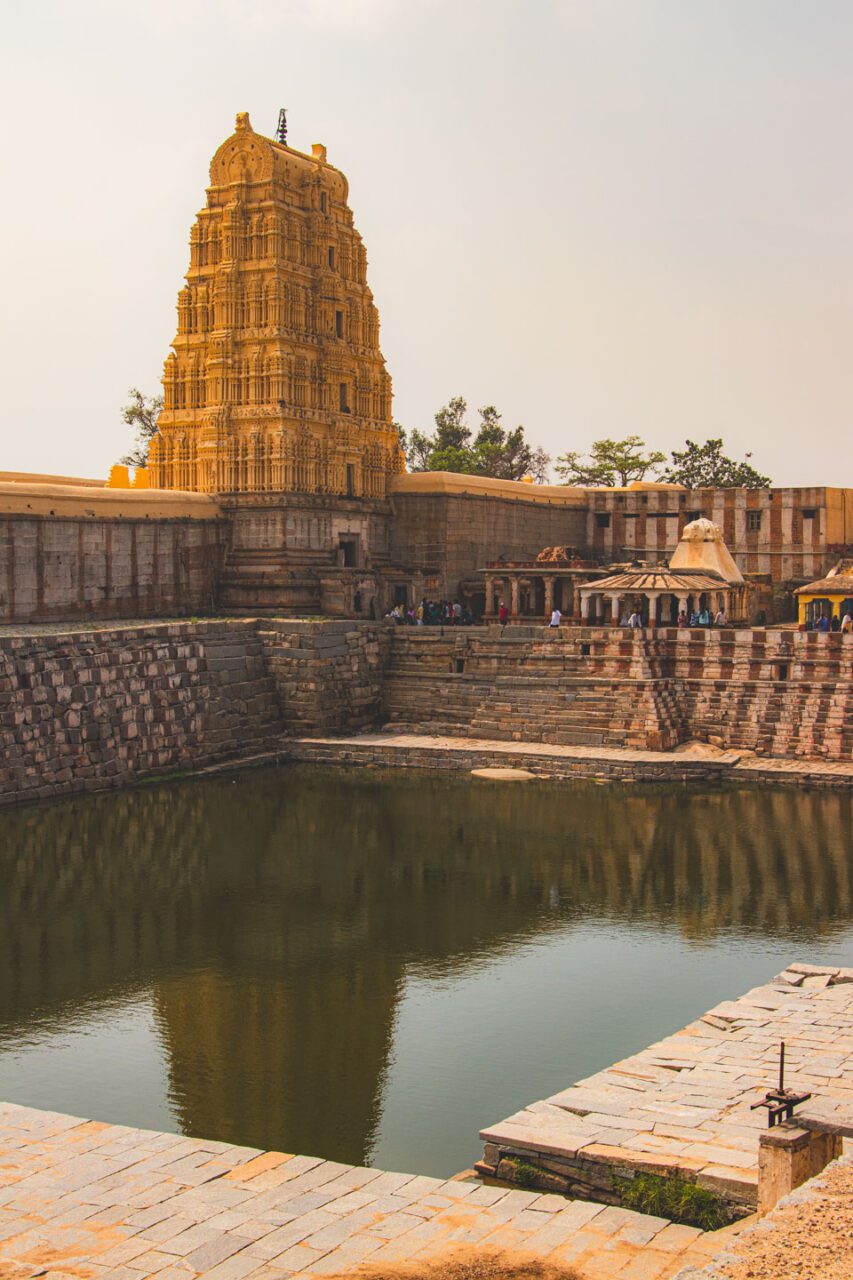
Good to know:
- The main tower (gopura) rises over 50 meters high.
- A temple elephant named Lakshmi gives “blessings” to visitors (a bit controversial).
- Expect authenticity – along with dust, stray dogs, and the raw beauty of India.
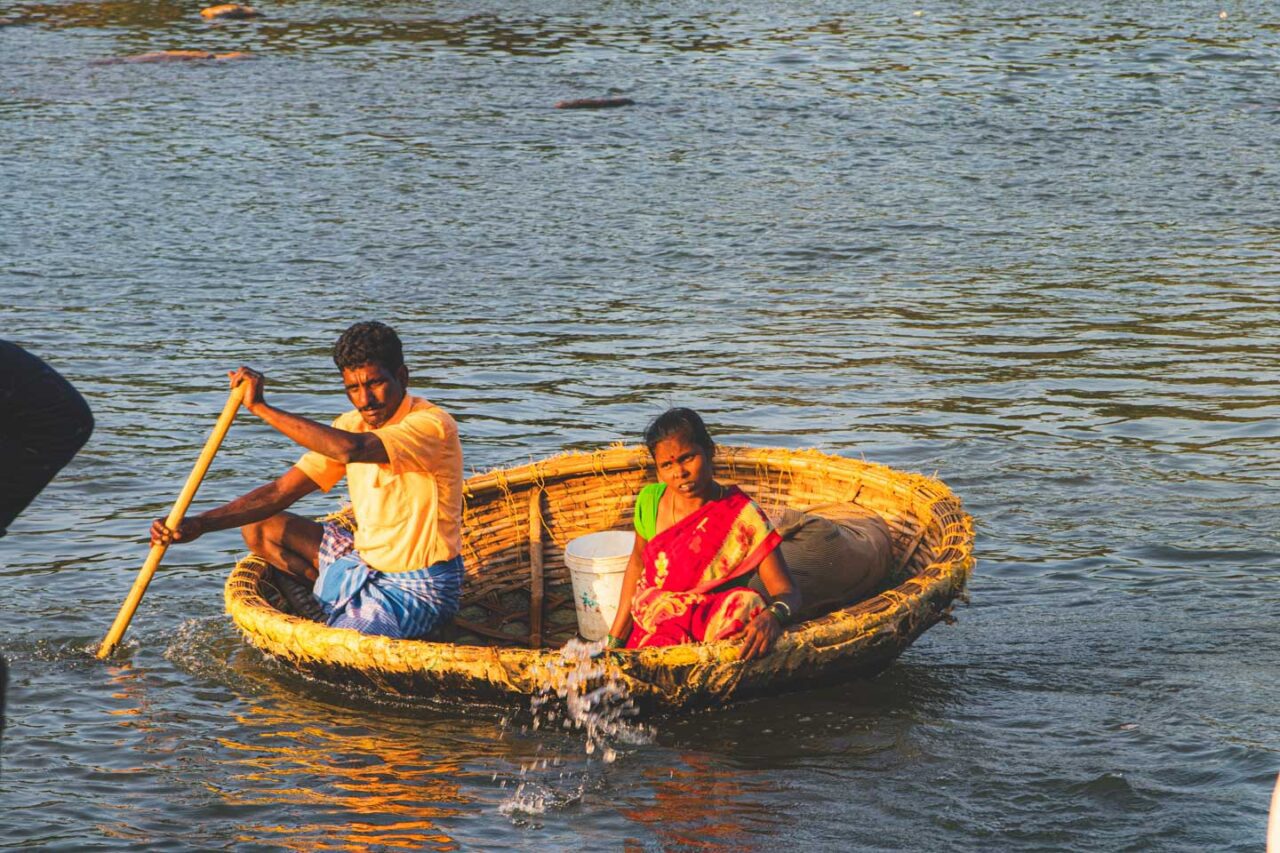
Matanga Hill – the best view in Hampi
If I had to choose just one place in Hampi to climb at dawn, it would be Matanga Hill.
It’s the highest point in the area – and hands down the best spot for sunrise (or sunset). The views from the top? Pure magic. The feeling once you get there? Even better.
Start your climb from the east end of Hampi Bazaar. There are two routes:
- The western one – steeper, with stone steps and raw charm (we took this one by accident).
- The eastern one – gentler, passing through three small temples.
At the top, you’ll reach the Veerabhadra Temple, dedicated to Shiva.
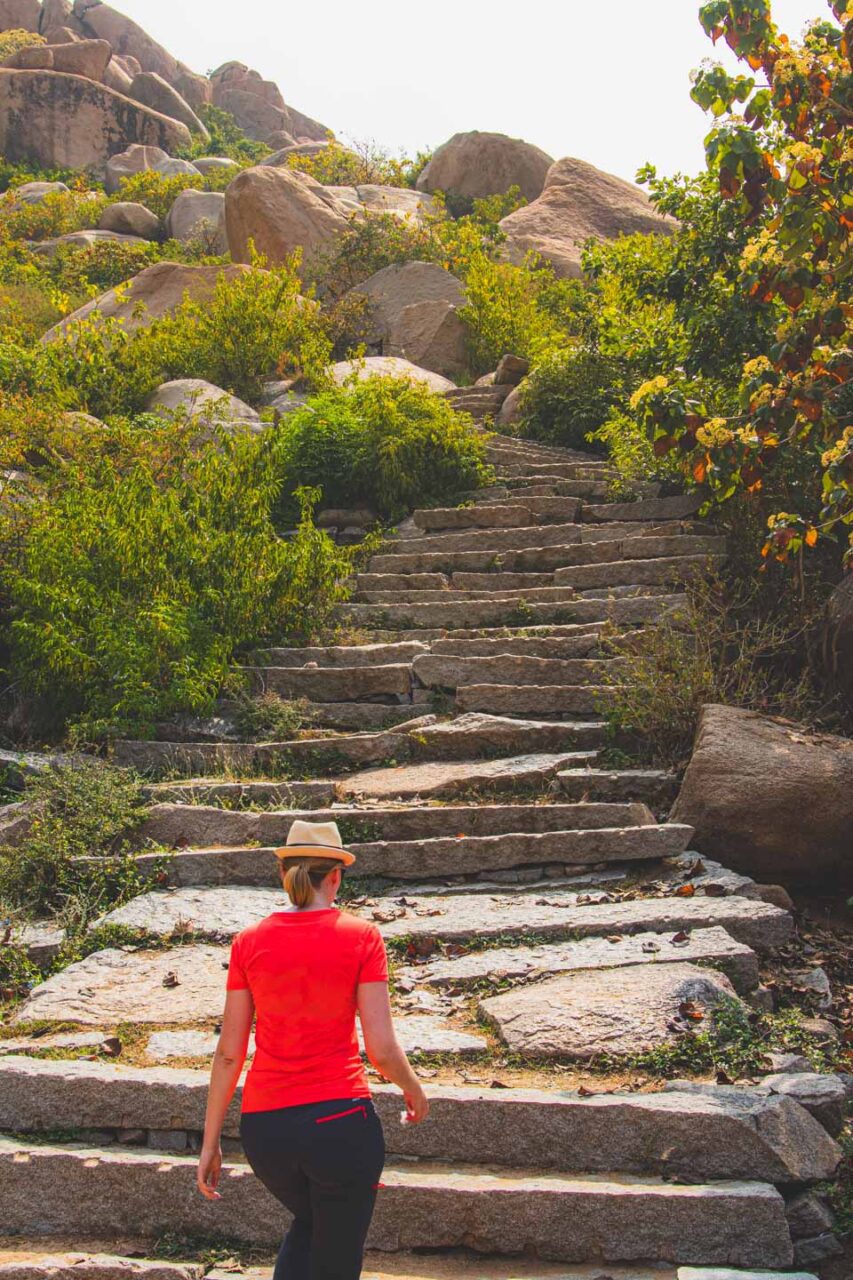
From the summit you’ll see:
- The winding Tungabhadra River
- Lush banana plantations
- The Virupaksha Temple rising from the valley
- The ruins of Achyutaraya Temple
Pro tip: Bring water, sunscreen, and a sense of wonder – this view will stay with you forever.
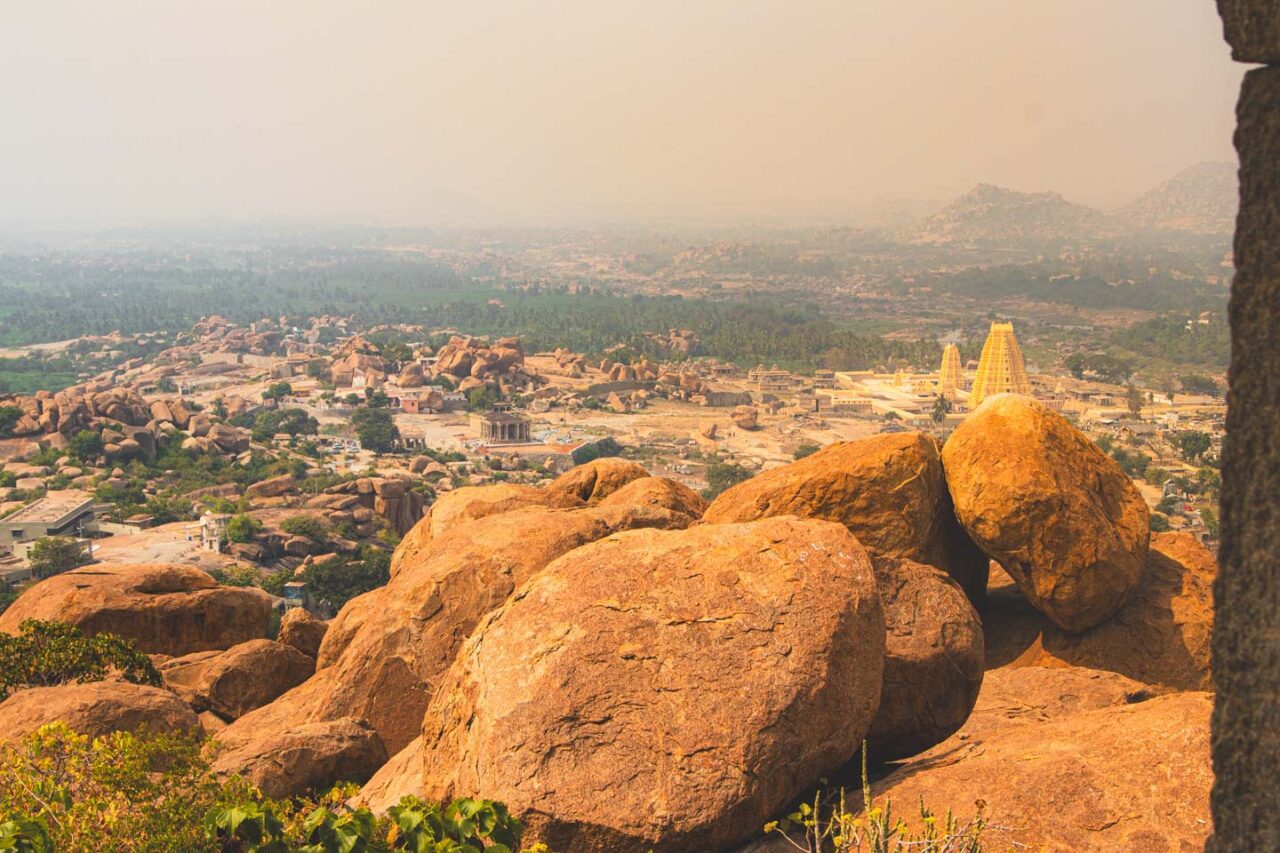
Planning your perfect India adventure?
I share hidden temples, sunrise spots, and insider tips from every incredible destination I explore across India and beyond.
Bonus for new subscribers: My Mumbai map with 100+ attractions for your phone 📱
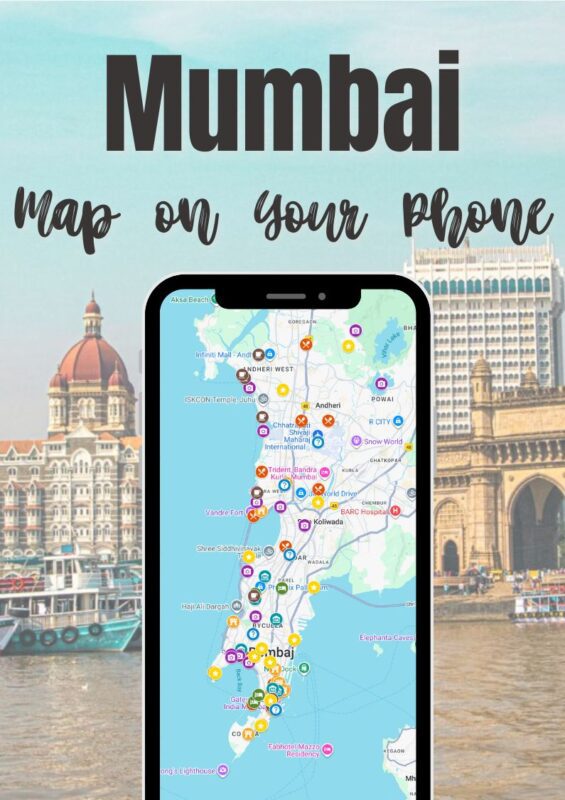
Krishna Temple & Bazaar – spirituality in ruins
This temple may no longer shine as it once did, but it still holds something truly special.
Built in the 16th century by King Krishnadevaraya as a tribute after his victorious campaign, today it stands mostly in ruins – but oh, what beautiful ruins they are.
Next to the temple lies an ancient bazaar lined with stone pillars – walking through it feels like stepping back in time.
Pro tip: Visit before noon, when the light gently hits the sandstone. It’s quieter than Virupaksha or Vittala, yet just as photogenic.
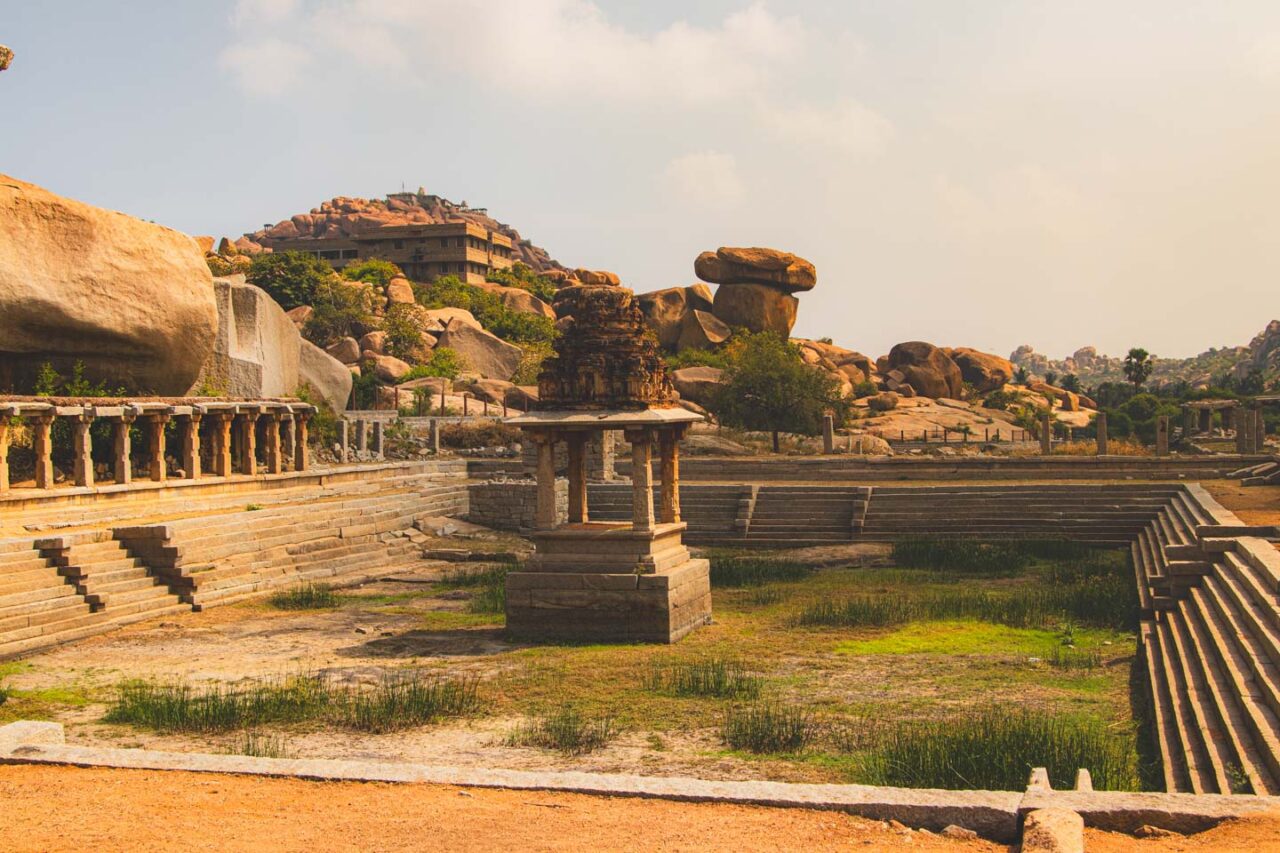
Lakshmi Narasimha Temple – raw power and emotion
This temple is a complete contrast to the intimate Matanga or the symmetry of Vittala.
Here, monumentality reigns – the nearly 7-meter-tall statue of Narasimha (the lion-headed incarnation of Vishnu) looks as if it could come alive at any moment.
Originally, the goddess Lakshmi sat on Narasimha’s lap, but today only her hand remains, gently resting on his arm.
A small detail – yet it gives the sculpture incredible emotional depth. Peaceful strength and quiet sorrow in one.
It’s the perfect place to pause, sit down, and simply… take it all in.
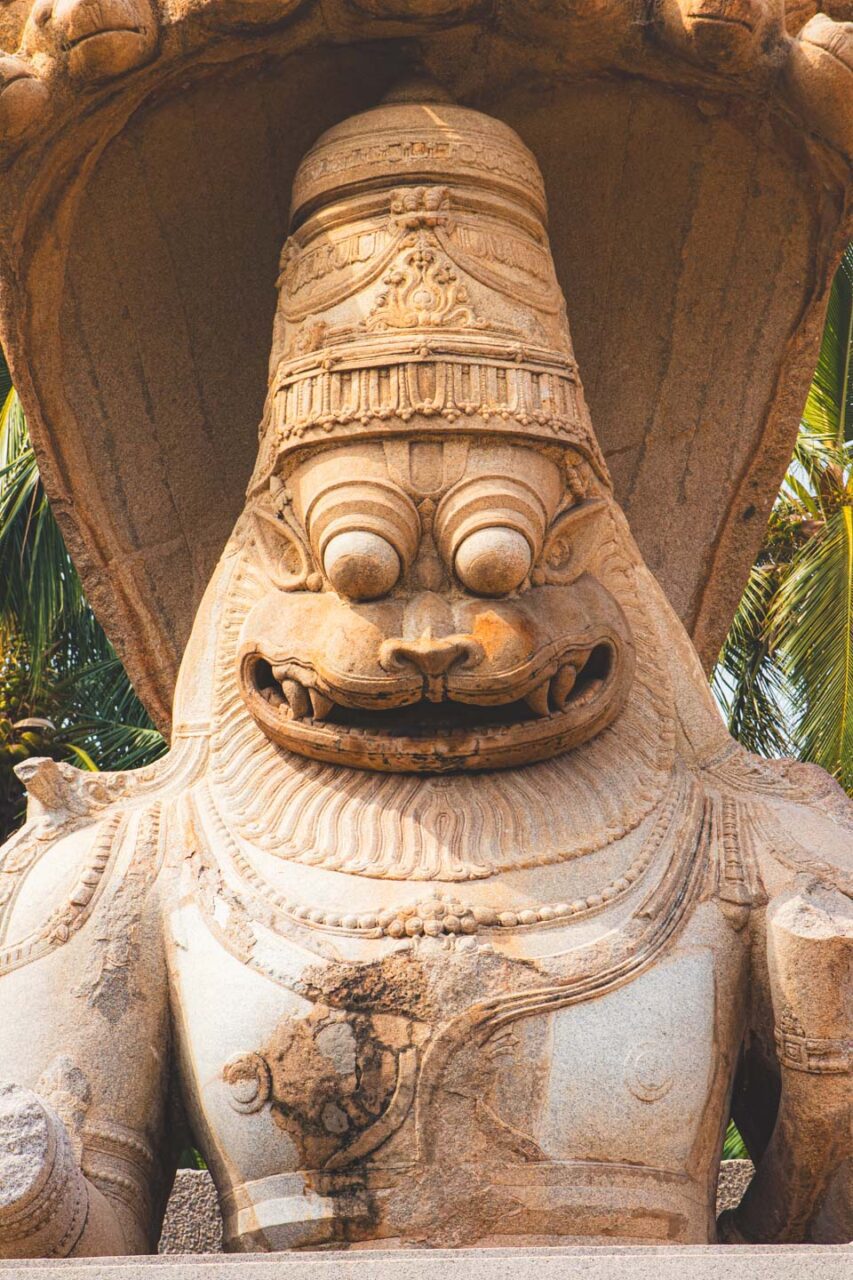
Chandikeshwara Temple – a sculptor’s masterpiece
This is one of those temples that looks modest from the outside but hides pure artistry within.
Dedicated to Vishnu, Chandikeshwara Temple mesmerizes with its intricately carved pillars and the figures of mythical creatures called yali – part lion, part dragon.
It’s one of the best-preserved temples in all of Hampi, perfect for anyone who loves details, ornamentation, and stone architecture with soul.
Pro tip: If you love photographing textures and light and shadow play – this place is your paradise.
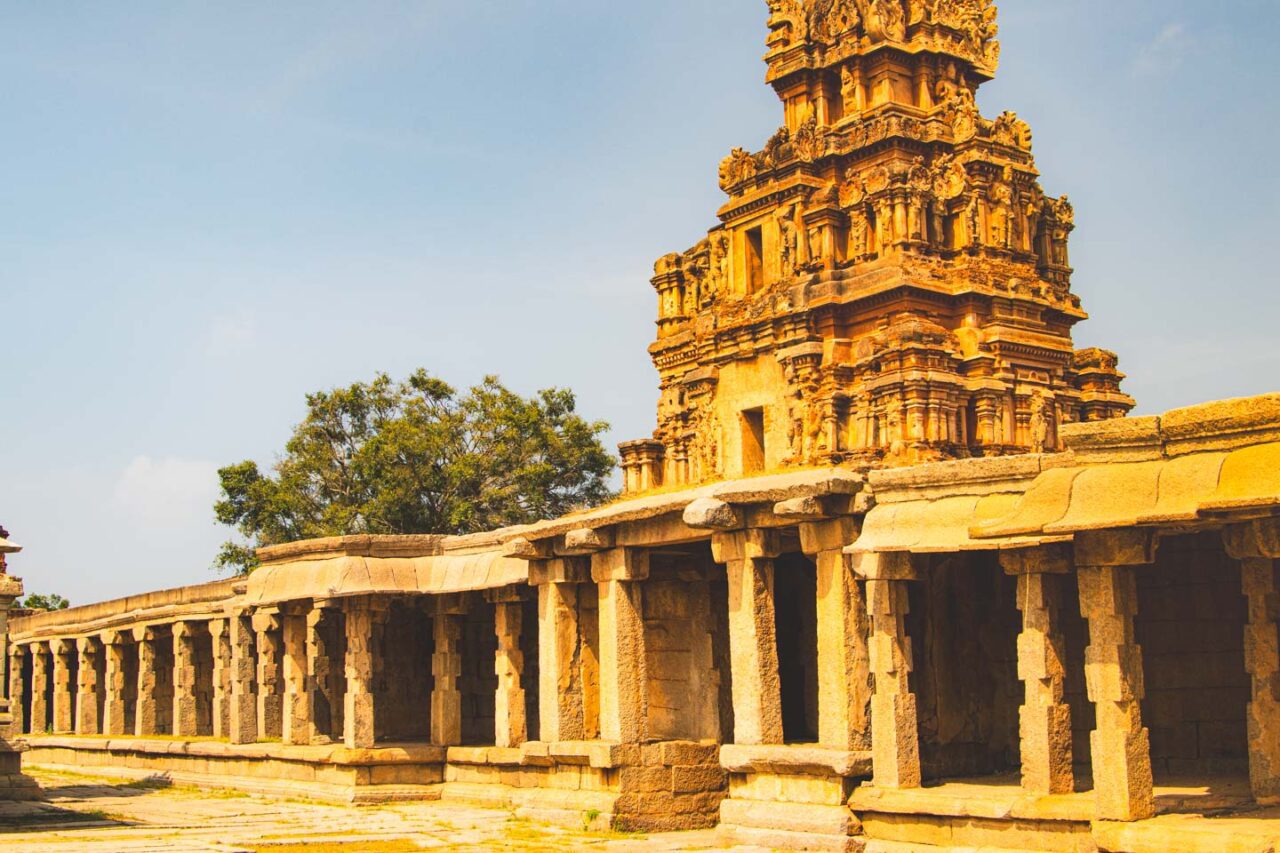
Underground Shiva Temple – mysterious and half-submerged
This place is, quite literally, a dive into history. The temple sits partially below ground – no one really knows why – but its flooded chambers make it one of the most atmospheric sites in Hampi.
For most of the year, the inner sanctum is covered with water, adding to its quiet mystery. Walking inside feels like stepping into a hidden chamber frozen in time.
During monsoon season, the water can rise to your ankles (or higher), so plan your footwear accordingly. But trust me – the cool air, the silence, and the reflections make it totally worth it.
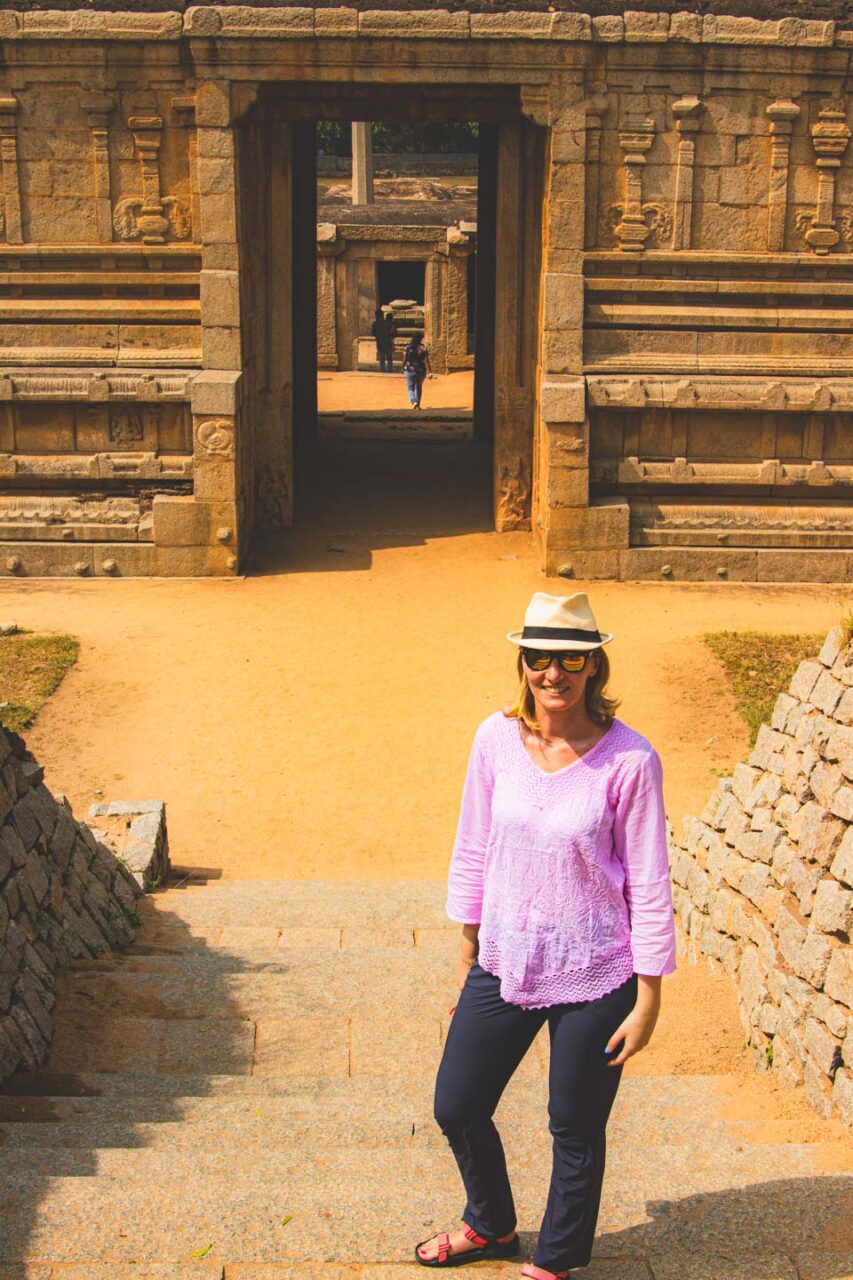
Zenana Enclosure & Lotus Mahal – the queen’s sanctuary (with a secret)
At first glance, this area looks like a typical part of a royal palace… but the story isn’t that simple.
The Zenana Enclosure was believed to be the women’s quarters of the Vijayanagara palace – though some say it served completely different purposes. Who knows what really happened behind those walls?
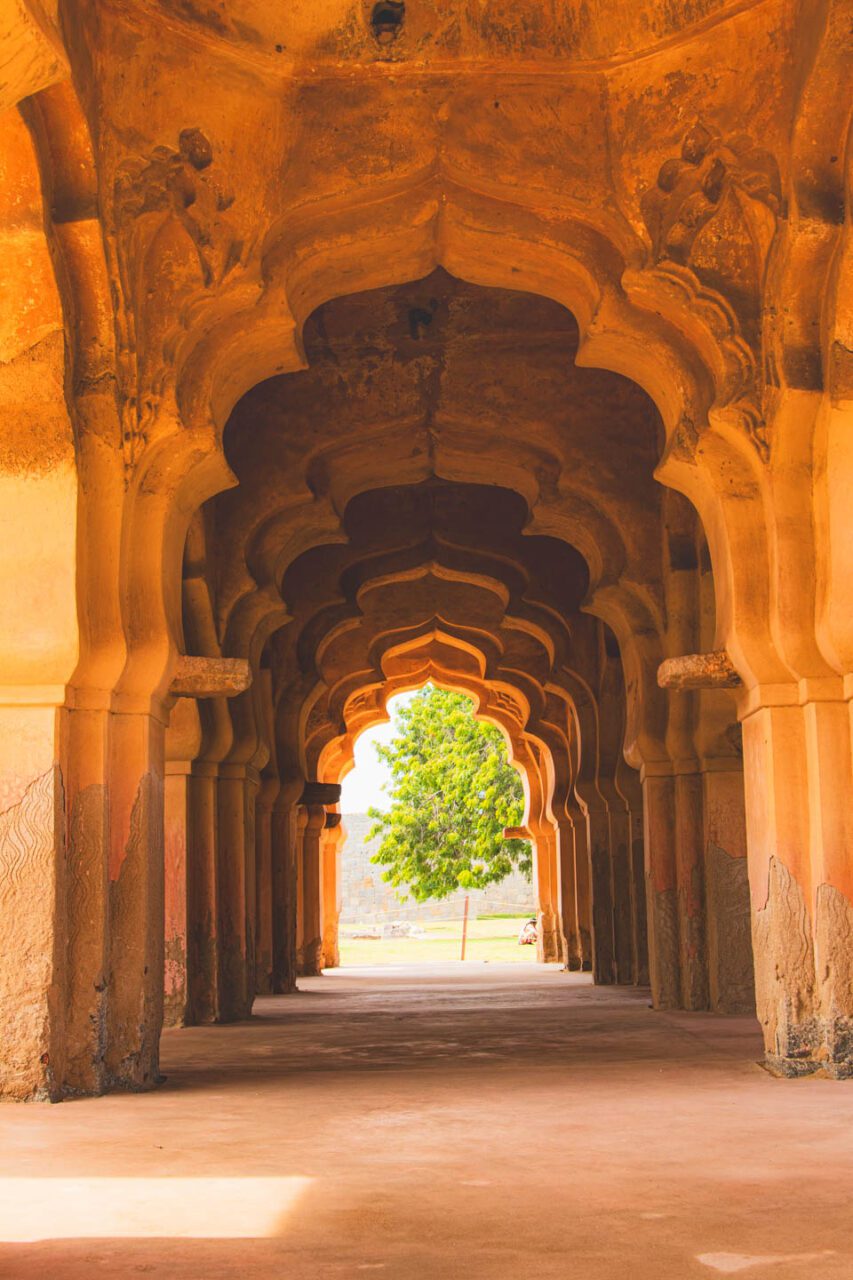
Inside, you’ll find a true architectural gem – the Lotus Mahal, a delicately arched, perfectly symmetrical palace that looks straight out of a fairytale.
Right next to it stand the Elephant Stables – a massive structure with eleven domes, both monumental and beautiful.
Pro tip: Bring your camera – this is one of the most photogenic spots in all of Hampi.
Note: This is one of the few sites in Hampi with a higher entrance fee for foreign visitors (about 25 times more than for locals) – but it’s absolutely worth it.
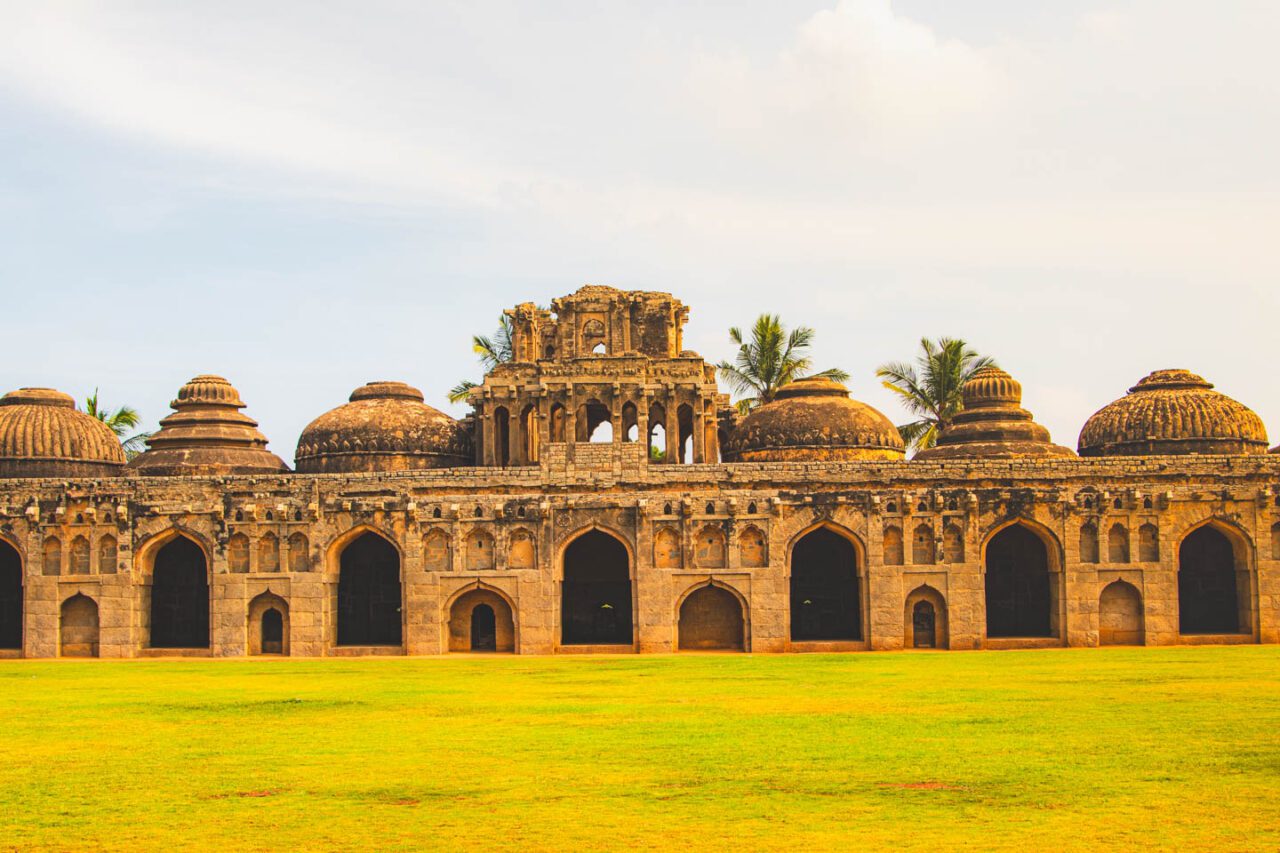
How do you want to explore India next?
🏖️ Need a chill break after exploring? → Palolem Goa Guide
🏔️ Chasing the best views? → Matanga Hill Guide
🍛 Curious about South India vibes? → Best Things to Do in Kochi
🏙️ Craving city energy? → Mumbai Travel Guide
What calls to you most?
Stepped Tank & Mahanavami Platform – a royal perspective
Monumental on one hand, yet peaceful enough for a moment of quiet reflection.
The stepped water tank impresses with its size and perfect geometry – you can almost picture how it once collected monsoon rain for the royal city.
Right next to it stands the Mahanavami Platform, a three-tiered stone terrace where kings once watched festivals and processions during the Dasara celebrations.
Today, you can sit on one of the ancient steps and simply gaze at the ruins. It’s deeply calming – a place where time seems to pause.
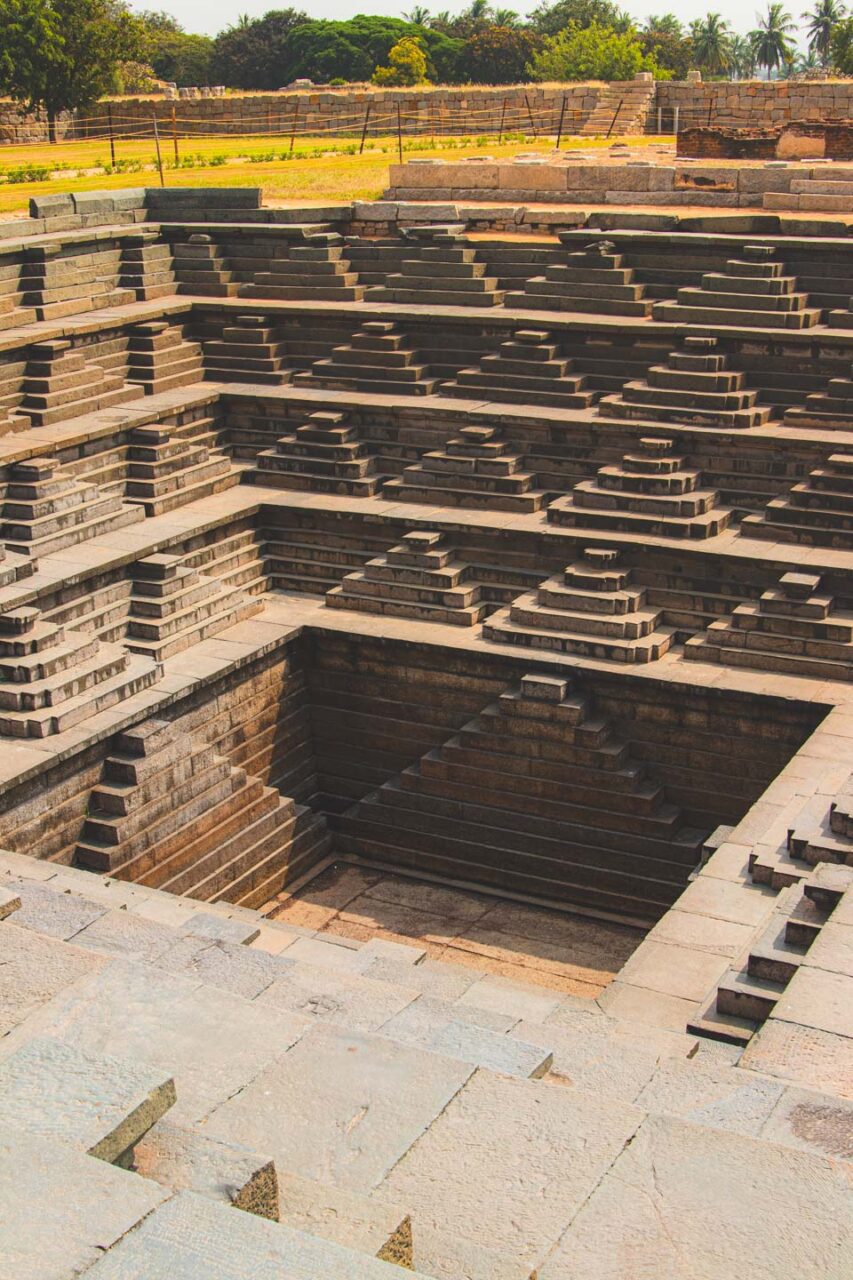
Queen’s Bath – silence, echoes, and Islamic arches
From the outside, it looks rather simple – but step inside, and you’ll be surprised by its space and detail.
The Queen’s Bath was built in the Indo-Islamic style, featuring graceful arches and an open inner courtyard that once held a central pool.
And despite its name, it wasn’t only for the queen – the king used it too (though that’s just a small royal secret).
It’s the perfect spot for a short stroll and a few photos – shady, cool, and beautifully echoing with every step.
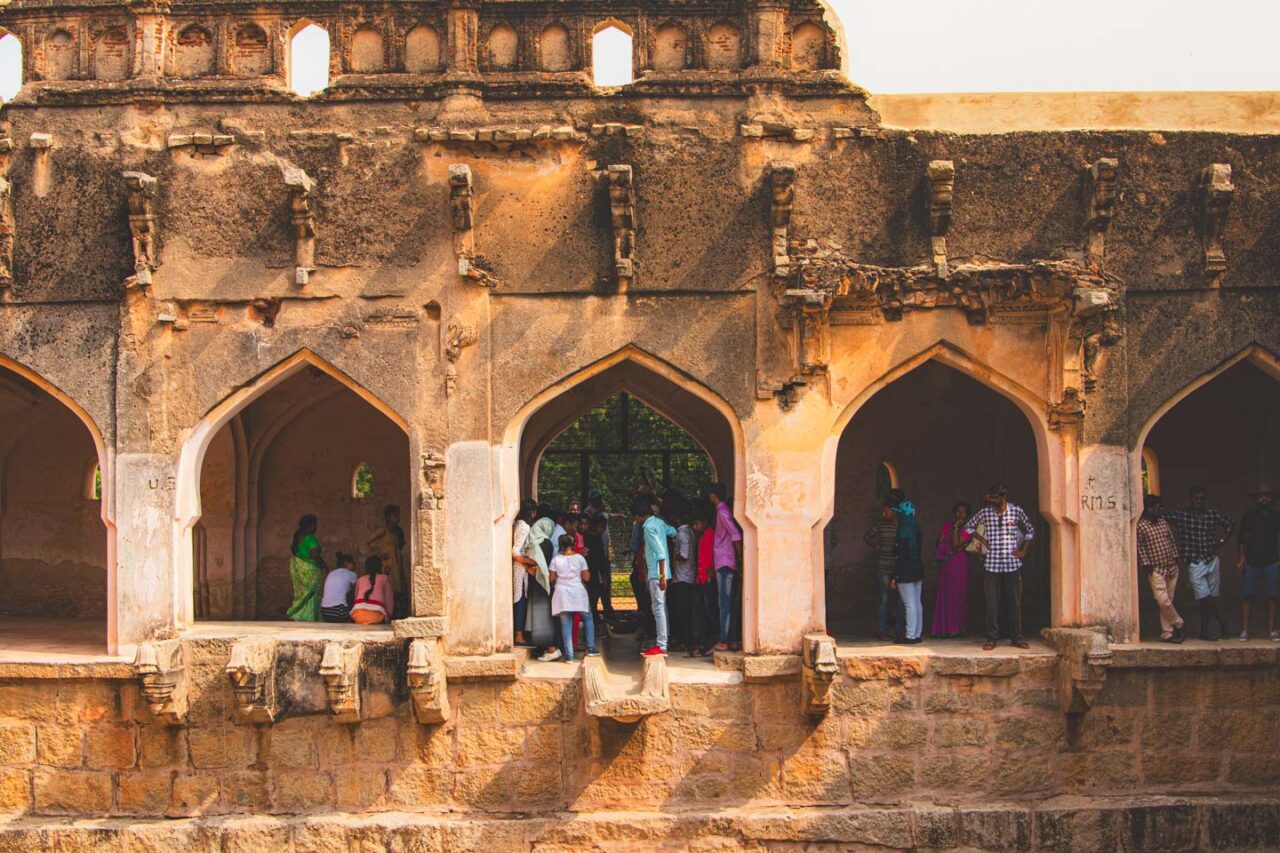
When to Visit Hampi
If you’re planning a trip to Hampi, the best time to go is from October to March.
The weather is gentler, the sun less punishing, and the landscapes stay beautifully green.
- November to February is peak season – more tourists, but also the best conditions.
- March is quieter yet still pleasant.
- April to June brings intense heat (not recommended unless you love saunas ).
- Monsoon season (July to September) is scenic but slippery – some temples may even be partially flooded.
I visited in November, and it was absolutely perfect.
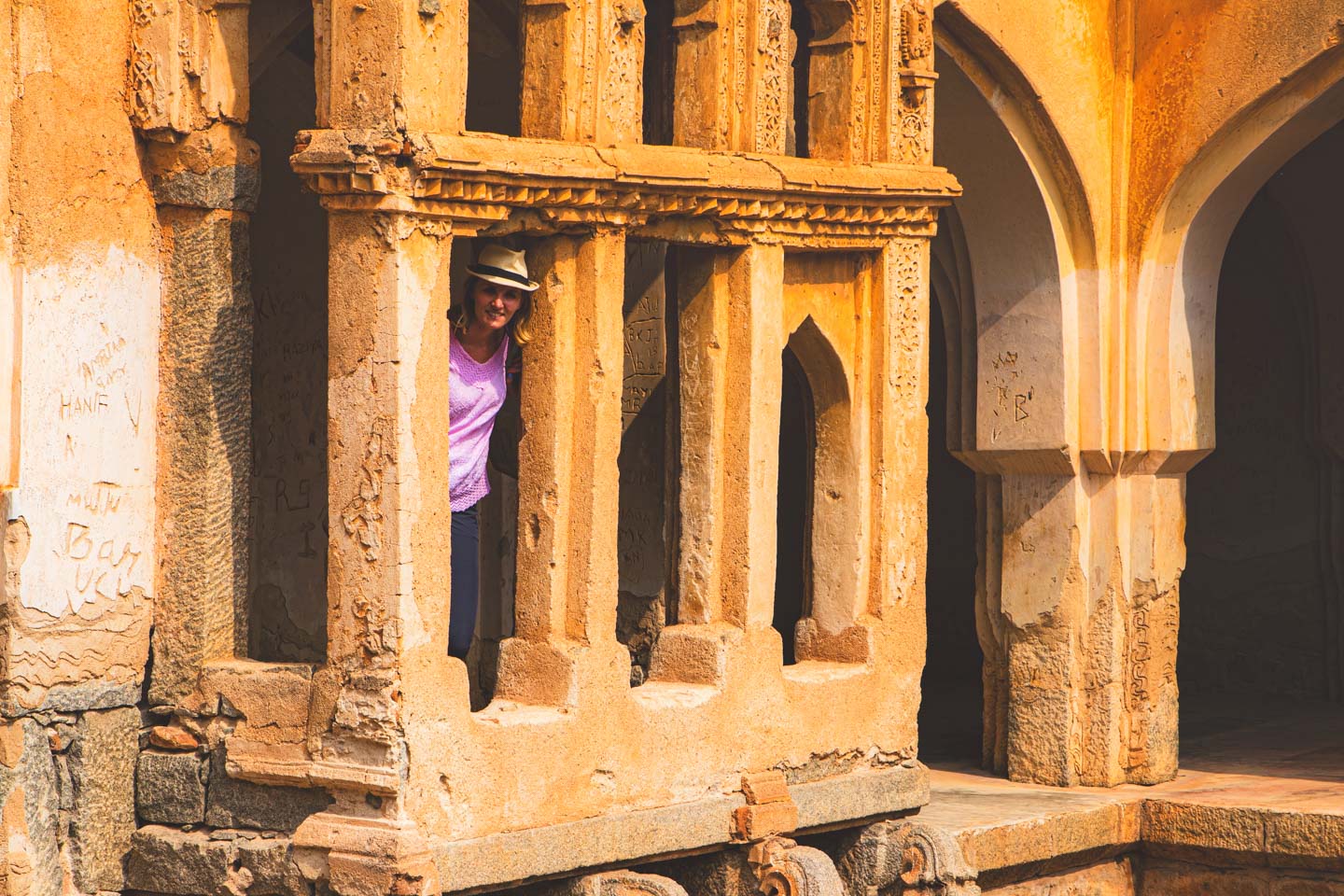
How to Get to Hampi
By Train
The easiest way is to take a train to Hospet Junction, located about 13 km from Hampi.
From Hospet, you can easily catch a tuk-tuk or local bus (they run every 30 minutes starting around 5:45 a.m.).
From Goa, the train from Margao takes roughly 8 hours – scenic and comfortable.
From Bangalore, there are several daily connections as well.
Book your tickets through IRCTC, the official Indian Railways website – it’s safe, reliable, and helps you avoid unnecessary middlemen or extra fees.
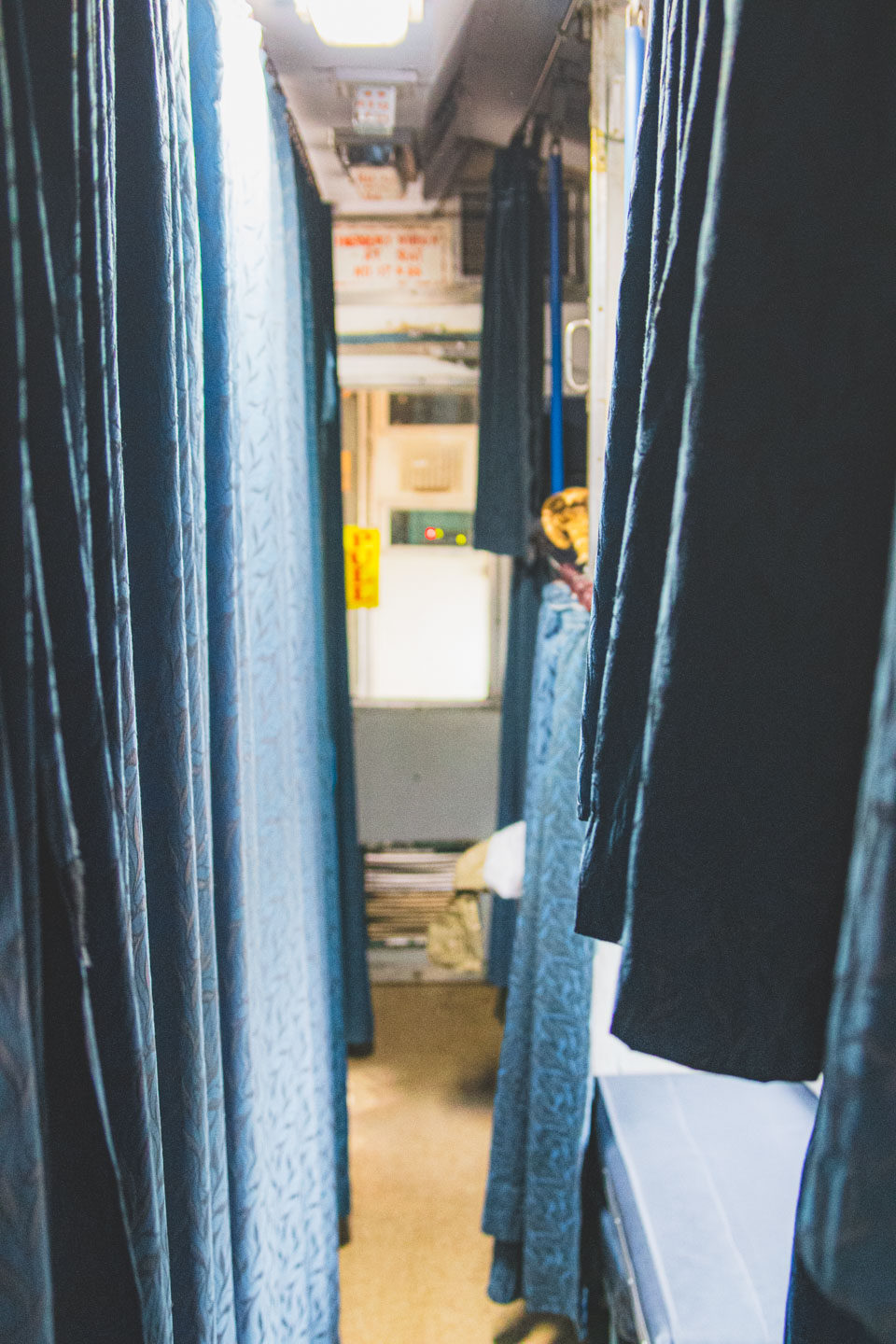
By Bus
There are night buses from Bangalore, Goa, and Hubli, run by private operators.
Personally, I prefer the train – it’s more comfortable and often in better condition than you’d expect.
But if you like the idea of sleeping through the journey and waking up right in Hampi at sunrise, the overnight bus might be perfect for you.

Getting Around Hampi
Hampi is vast, and the distances between temples can be surprising. Under the midday sun, walking quickly turns into a challenge, so the best way to explore is to hire a rickshaw with a driver for the whole day.
That’s exactly what I did – and it’s the only reason I managed to see so much without rushing, from ancient ruins to quiet viewpoints tucked away between the rocks.
You can easily find rickshaws near the Virupaksha Temple or by the main parking area.
The daily rate is around ₹1000-1200, depending on your route and the number of stops. It’s a good idea to agree on the plan in advance – most drivers have their favorite spots but are happy to adjust to your preferences.
It’s more than just transport – it’s part of the adventure. A slow ride, a stop for chai, a few stories from your driver, and moments of stillness under the palm trees.
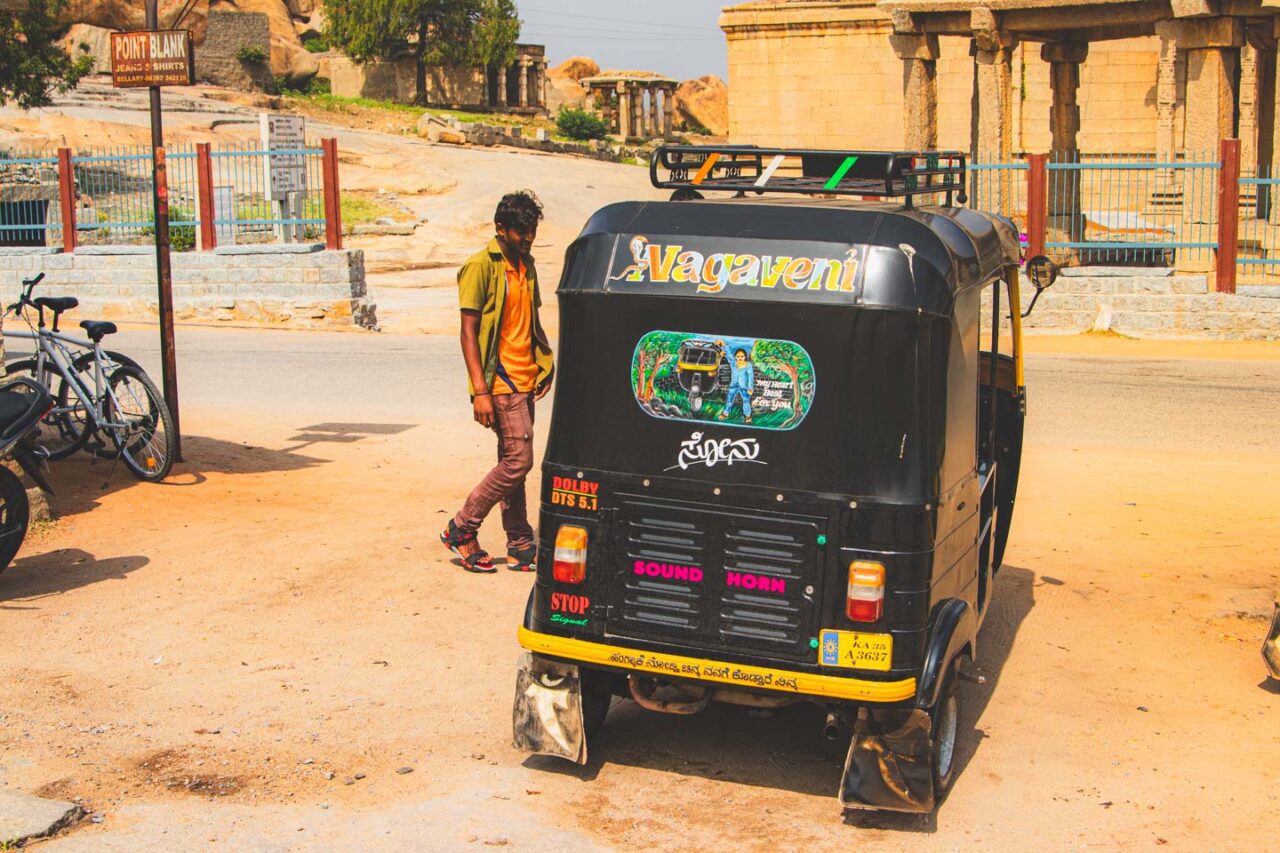
Where to Eat in Hampi
Mango Tree – a timeless classic with soul
Mango Tree is one of those Hampi legends everyone recommends – and for good reason.
The moment you walk in, you feel the vibe: guests lounging on cushions, sunlight filtering through the trees, soft music in the background, and the gentle sound of the river nearby.
It’s the kind of place where you’ll want to linger – not just for lunch, but to rest, recharge, and soak in the calm between temple visits.
The menu is full of Indian comfort classics – aromatic curries, homestyle thalis, spiced vegetables, fresh chapati, and the best mango lassi in town.
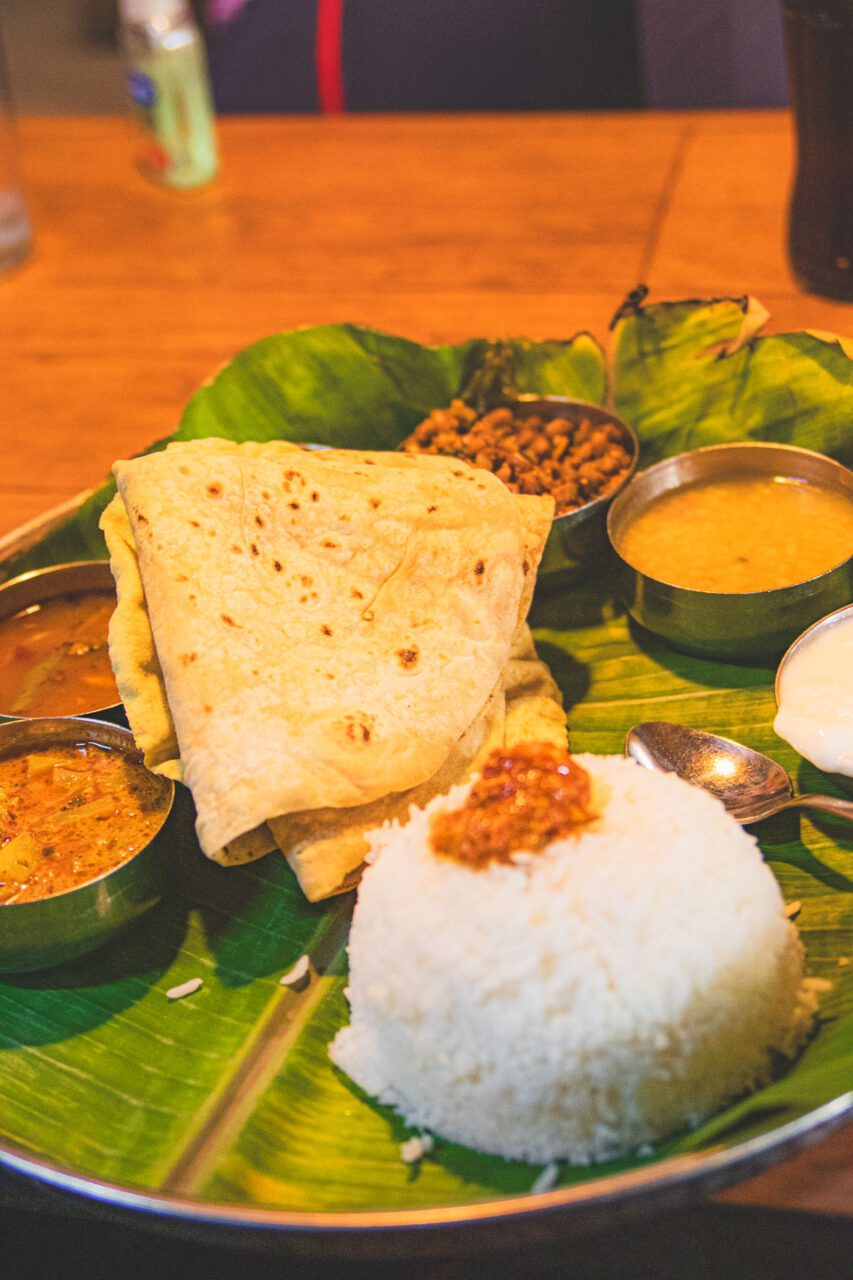
My dream order?
- Yellow cashew curry – creamy with just the right hint of spice
- Warm, freshly baked chapati
- Chilled mango lassi – the perfect refreshment on a hot day
If you’re after a place with both soul and flavor, Mango Tree is an absolute must.
Laughing Buddha – chill with a temple view
If you’re dreaming of a place where you can enjoy good food and a view of the river and ancient ruins – Laughing Buddha is the spot.
Perched right on the banks of the Tungabhadra River, this café blends a hippie vibe with postcard-perfect scenery.
Think hammocks, low tables, bamboo roofs, and the gentle sound of temple bells drifting in from afar.
The menu is a fusion of Indian and Western favorites – from comforting paneer butter masala and colorful veg thalito surprisingly good pizzas and veggie burgers.

My picks:
- Paneer butter masala – rich, creamy, and perfectly spiced
- Vegetarian thali – bursting with flavor, color, and texture
- A fresh mango juice with ice – simple, sweet, and refreshing
This is a place where time slows down, food tastes better, and you feel wrapped in the embrace of nature and history.
Pro tip: Come during golden hour – sunset over the river with the temples glowing in the distance is pure magic.
Where to Stay in Hampi & How to Cross the River
Most accommodations are located across the Tungabhadra River, in an area known as Hampi Island or Hippie Island.
It’s the quieter side – filled with palm trees, small guesthouses, and peaceful rice fields.
To get there, you’ll need to cross the river by boat from the main side near Virupaksha Temple. Boats run from early morning until sunset and cost just a few rupees.
The short ride itself is part of Hampi’s charm – for a brief moment, you feel like you’re leaving behind the world of ancient ruins and entering a serene, green village where time slows down.
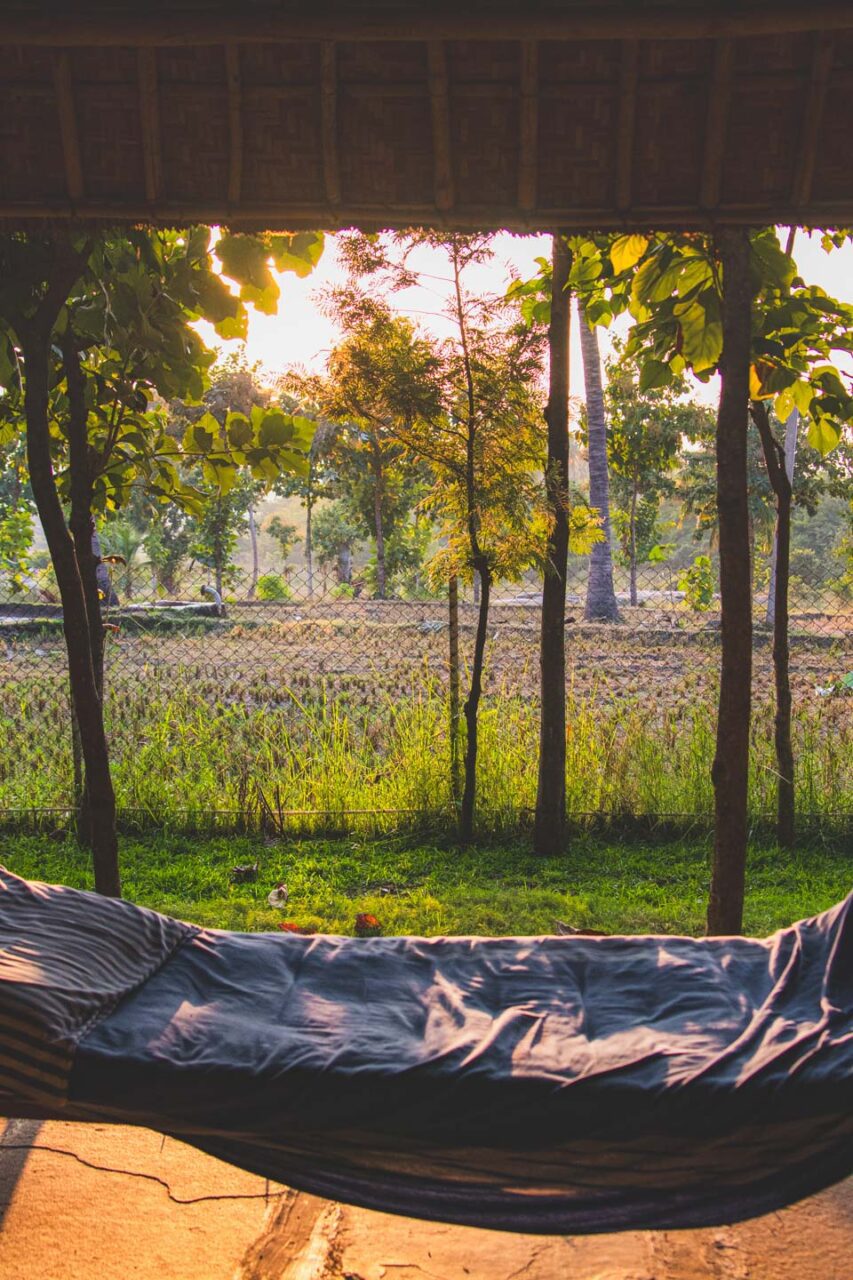
Travel Budget Calculator
Get your free Travel Budget Calculator now and plan your trip without the stress of overspending!
Why Hampi Changed How I See Ancient History
Standing among Hampi’s ruins, watching the sunset paint those 500-year-old temples golden, something shifted in me.
This wasn’t just another UNESCO site to check off – it was a place that made history feel alive.
Every crumbling pillar, every carved stone, every temple told a story of an empire that once ruled Southern India.
The way locals still worship at these ancient sites, the peaceful atmosphere despite the crowds, the feeling of stepping back in time – Hampi isn’t just about seeing monuments.
It’s about feeling the weight of centuries and understanding that some places are truly sacred.
The climb up Matanga Hill tested me. The heat challenged me.
But watching dawn break over this ancient landscape while those temple bells rang in the distance? That’s the kind of moment that reminds you why you travel in the first place.
Hampi taught me that sometimes the best destinations aren’t the easiest to reach, and that comfort zones are meant to be stepped out of.
This place rewards effort with wonder, curiosity with discovery, and patience with magic.
Ready to explore more of incredible India?
- Palolem Guide – Find Goa’s most beautiful hidden beach
- Complete Hampi Guide – Discover all 12 temples and ruins you can’t miss
- Kochi in One Day – Experience Kerala’s cultural gems
- Mumbai Travel Guide – Navigate India’s most vibrant city with confidence
Have you visited Hampi? Which temple or view took your breath away?
Share this with someone planning their India adventure, and tell me about your Hampi experience in the comments!
